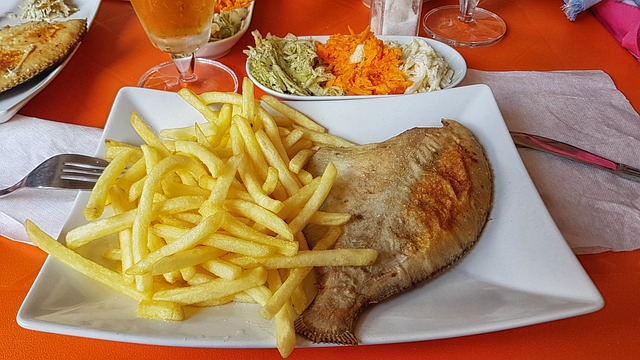What Does Flounder Taste Like?

What does flounder taste like?
Picture this: a delicate, flat fish swimming in the ocean depths, catching the curiosity of seafood enthusiasts, leads us to the question, “What Does Flounder Taste Like?” This article aims to unravel the delightful taste of flounder, exploring its nuanced flavors and providing insights that go beyond the ordinary. Let’s dive into the world of this delectable fish and understand why it’s a favorite among seafood enthusiasts.
What is Flounder?
Flounder is a type of flatfish belonging to the family Pleuronectidae. These fish are known for their distinctive flat bodies and a unique adaptation where both of their eyes are located on one side of the head, allowing them to lie flat on the ocean floor. This adaptation helps them camouflage themselves in the sand or mud, making them effective ambush predators.
Flounder is a popular edible fish and is commonly caught for consumption. It is found in both saltwater and brackish environments, including coastal areas and estuaries. There are several species of flounder, and they can be found in different regions around the world. The taste and texture of flounder make it a favorite choice for seafood dishes, and it is often prepared in various ways, such as baking, grilling, or frying.
Flounder Species and Varieties
Flounder comes in various species, each with its distinct taste profile. From the mild taste of European flounder to the slightly sweet notes of Summer flounder, understanding these differences allows culinary enthusiasts to make informed choices when selecting this fish for their recipes.
What Does Flounder Taste Like?
Flounder has a mild, delicate flavor with a slightly sweet and nutty undertone. The flesh is white, lean, and flaky when cooked. The taste is often described as clean and not overly fishy, making it a versatile fish that can easily take on the flavors of various seasonings and preparations. It is a popular choice for those who prefer a milder fish flavor, and its texture makes it suitable for various cooking methods, such as baking, grilling, or pan-frying.
Flounder Diet and Impact on Flavor
The old saying “you are what you eat” holds true for flounder. Delving into the depths of its diet, we uncover how the fish’s natural food sources contribute to its flavor. Whether feasting on crustaceans or small fish, the flounder’s diet plays a crucial role in determining the taste on your plate.
How To Prepare Flounder For Cooking?
Preparing flounder for cooking is a straightforward process. Here’s a basic guide on how to clean and prepare flounder for cooking:
Ingredients and tools:
- Fresh flounder
- Sharp fillet knife
- Cutting board
- Paper towels
- Lemon (optional)
- Seasonings of your choice (salt, pepper, herbs, etc.)
Instructions:
- Rinse the flounder under cold running water to remove any loose scales or debris.
- Use paper towels to pat the flounder dry. Removing excess moisture helps with a better sear if you’re pan-frying or grilling.
- Remove Skin (Optional): Some prefer to keep the skin on for added flavor, but if you want to remove it, use a sharp knife to gently lift the edge of the skin and slide the knife between the skin and flesh, working your way across.
- Remove Bones (Optional):
- Check for any small bones by running your fingers over the flesh. Use tweezers or pliers to pull out any bones you find.
- Season the flounder with salt, pepper, and any other desired herbs or spices. A squeeze of lemon can enhance the flavor.
How Do You Cook Flounder?

There are various ways to cook flounder, and the method you choose often depends on your personal preferences and the flavor profile you’re aiming for. Here are a few popular methods:
1. Pan-Frying Flounder:
Ingredients:
- Flounder fillets
- Salt and pepper to taste
- Flour (optional)
- Olive oil or butter for cooking
- Lemon wedges for serving
Instructions:
- Season the flounder fillets with salt and pepper.
- Optionally, dredge the fillets in flour for a crispy coating.
- Heat olive oil or butter in a skillet over medium-high heat.
- Cook the fillets for 2-3 minutes per side, or until they are golden brown and easily flake with a fork.
- Squeeze fresh lemon juice over the fillets before serving.
2. Baking Flounder:
Ingredients:
- Flounder fillets
- Olive oil or melted butter
- Lemon juice
- Garlic powder, paprika, salt, and pepper for seasoning
- Fresh herbs (parsley, dill, or thyme)
Instructions:
- Preheat the oven to 400°F (200°C).
- Place the flounder fillets on a baking sheet lined with parchment paper.
- Brush the fillets with olive oil or melted butter.
- Season with garlic powder, paprika, salt, pepper, and a squeeze of lemon juice.
- Bake for 10-15 minutes, or until the fish flakes easily with a fork.
- Garnish with fresh herbs before serving.
3. Grilling Flounder:
Ingredients:
- Flounder fillets
- Olive oil
- Lemon juice
- Garlic, minced
- Salt, pepper, and your choice of herbs (rosemary, thyme)
Instructions:
- Preheat the grill to medium-high heat.
- Brush the flounder fillets with a mixture of olive oil, lemon juice, minced garlic, salt, pepper, and herbs.
- Place the fillets on the grill and cook for 3-4 minutes per side, or until the fish is opaque and flakes easily.
- Serve with additional lemon wedges.
These are just a few basic methods, and you can experiment with different seasonings and cooking techniques to suit your taste preferences. Whether pan-fried, baked, or grilled, flounder is a versatile fish that pairs well with various flavors.
Is Flounder A Good Fish To Eat?
Yes, flounder is considered a good fish to eat. It is a lean fish with a mild and delicate flavor, making it appealing to a wide range of palates. Here are some reasons why flounder is a popular and healthy choice:
- Low in Fat: Flounder is a lean fish, which means it is low in fat, particularly saturated fat. This makes it a good option for those looking to maintain a healthy diet.
- High in Protein: Like many fish, flounder is a good source of high-quality protein. Protein is essential for building and repairing tissues in the body.
- Rich in Nutrients: Flounder contains various vitamins and minerals, including vitamin B12, niacin, phosphorus, and selenium. These nutrients contribute to overall health and well-being.
- Omega-3 Fatty Acids: While not as high in omega-3 fatty acids as some other fish like salmon (you can learn about “what does salmon taste like?” on our website) , flounder still provides a moderate amount of these essential fatty acids. Omega-3s are known for their potential benefits to heart health.
- Versatile and Mild Flavor: Flounder has a mild taste and a delicate texture, making it versatile in the kitchen. It easily takes on the flavors of herbs, spices, and other seasonings, making it suitable for various cooking methods.
When choosing flounder, it’s advisable to opt for sustainably sourced and properly handled fish to ensure the best quality and minimize environmental impact. Additionally, individuals with specific dietary restrictions or health concerns should consult with a healthcare professional or nutritionist for personalized advice.
Health Benefits of Consuming Flounder
Beyond its taste, flounder offers a range of health benefits. We break down the nutritional value, highlighting the positive impact on heart health, brain function, and more. Discover the wholesome advantages of including flounder in your diet.
Flounder in Culinary Culture
Tracing the historical significance of flounder in various cuisines, we uncover cultural preferences and traditional recipes that showcase the versatility of this fish. From European classics to Asian delicacies, flounder has left its mark on culinary traditions worldwide.
Purchasing and Storing Flounder
To truly appreciate the taste of flounder, selecting and storing it correctly is paramount. Our guide provides tips on choosing fresh flounder and outlines proper storage methods to maintain its flavor and texture.
Frequently Asked Questions (FAQs)
Q: Can Flounder be Overpowered by Strong Flavors?
Absolutely not. Flounder’s mild taste is versatile, allowing it to complement a wide range of seasonings without being overshadowed. Whether paired with bold spices or delicate herbs, flounder holds its own in any culinary creation.
Q: Is Flounder a Good Choice for Those New to Seafood?
Indeed, flounder’s mild flavor and delicate texture make it an excellent choice for seafood beginners. Its approachable taste provides a gentle introduction to the world of oceanic delights.
Q: Does Flounder Taste Fishy?
No, flounder is renowned for its minimal fishy taste. The mildness of its flavor profile makes it an ideal option for individuals who prefer seafood without the strong, characteristic fishiness.
Q: What Seasonings Complement Flounder Best?
Flounder’s versatile nature allows it to pair well with a variety of seasonings. Lemon, garlic, dill, and parsley are popular choices that enhance its natural flavors without overpowering.
Q: Can I Use Frozen Flounder in Recipes?
Absolutely. High-quality frozen flounder retains its freshness and taste. Ensure proper thawing before cooking to preserve the texture and flavors.
Q: Is Flounder Suitable for Grilling Whole?
Yes, flounder can be grilled whole for a visually stunning and delicious dish. Ensure the fish is cleaned and seasoned before grilling for an impressive presentation.
Conclusion
In conclusion, the question “What Does Flounder Taste Like?” leads us to a culinary revelation. Flounder, with its delicate texture, sweet flavor, and versatility, stands out as a gastronomic delight. Whether pan-seared, grilled, or baked, flounder offers a sublime dining experience that caters to a wide range of palates. Embrace the world of flounder, and let its taste elevate your culinary adventures.






